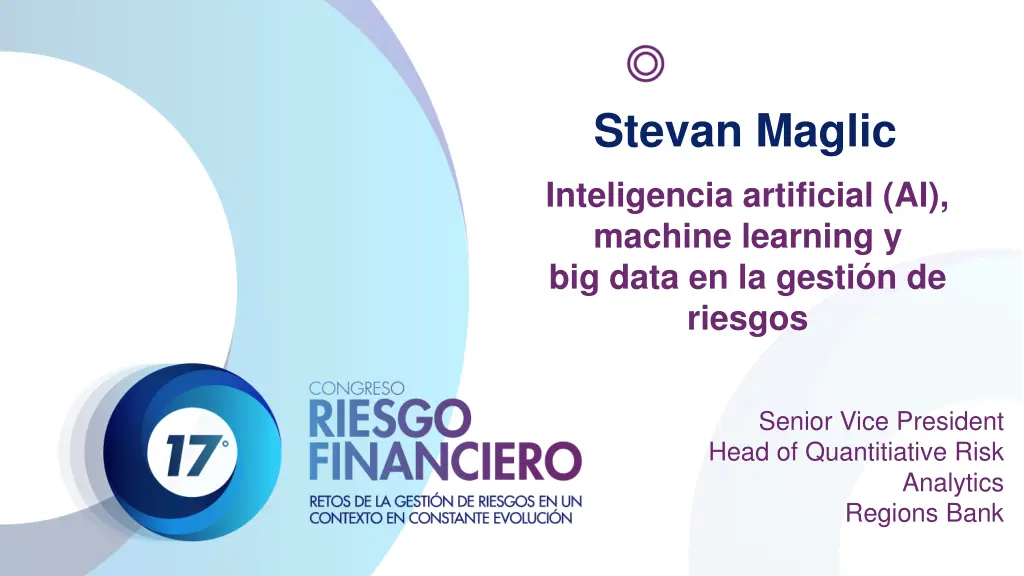
Transforming Risk Management in Banking with AI and Machine Learning
Discover the impact of artificial intelligence (AI), machine learning, and big data on risk management in banking through insights from Stevan Maglic, Senior Vice President at Regions Bank. Explore the challenges and benefits of implementing AI models, the unique regulatory environment in banking, and the shift towards developing non-traditional risk models. Gain valuable perspectives on model development, validation, and the future of AI integration in the banking industry.
Download Presentation

Please find below an Image/Link to download the presentation.
The content on the website is provided AS IS for your information and personal use only. It may not be sold, licensed, or shared on other websites without obtaining consent from the author. If you encounter any issues during the download, it is possible that the publisher has removed the file from their server.
You are allowed to download the files provided on this website for personal or commercial use, subject to the condition that they are used lawfully. All files are the property of their respective owners.
The content on the website is provided AS IS for your information and personal use only. It may not be sold, licensed, or shared on other websites without obtaining consent from the author.
E N D
Presentation Transcript
Stevan Maglic Inteligencia artificial (AI), machine learning y big data en la gesti n de riesgos Senior Vice President Head of Quantitiative Risk Analytics Regions Bank
The opinions expressed in the presentation are statements of the speaker s own, are intended only for informational purposes, and are not formal opinions of, nor binding on Regions Bank, its parent company, Regions Financial Corporation and their subsidiaries, and any representation to the contrary is expressly disclaimed.
Just as electricity transformed almost everything 100 years ago, today I actually have a hard time thinking of an industry that I don t think AI will transform in the next several years. Andrew Ng
Agenda 1. Banking Environment 2. Model Development and Validation Environment 3. Developing Less Traditional Models 4. The Range of Problems in Banking 5. Benefit and Challenges 6. Closing 7. Q&A
The Banking Environment One prime feature which uniquely differentiates banking is regulation History and Background Financial crisis Federal Reserve Bank created Dodd-Frank FASB has created CECL Very sophisticated models Model validation environment View of the Federal Reserve: proceed with caution!
Current Model Development and Validation Environment Banks have invested heavily in developing capacity to develop models internally There has been similar focus on model validation units Robust, Transparent and Repeatable Process Transparent model development and selection Independent review and testing Controlled production environment Change management and ongoing monitoring process Staff, models, and process geared towards econometric and more traditional statistical models The environment and mindset is a challenge for AI models
Towards Development and Implementation of Less Traditional Models Focus of Model Development Lower Risk Models Complement Traditional Models Challenger Models Segmentation Challenger Models Validation Revisit Policy and Procedures Heightened Ongoing Monitoring Standards Users More Focus on Understanding and Transparency Strengths and Weaknesses What model is doing and not doing
Range of Modeling Problems in Banking Financial mathematics (e.g., bond math, option pricing, etc.) VaR Models for market and credit risk Counterparty credit exposure, CVA, etc. Portfolio construction, optimization, etc. Credit models: default and recovery models Traditional machine learning models Econometric time series models Hazard Rate and Markov chain models Correlation models and loss correlation Op risk, fraud detection, anti-money laundering, etc.
Letting the Data Speak for Itself: Strengths and Weaknesses Strength Reveal relationships for with there is no theory Non-linear Relationships Interactions Reveal unexpected features in the data Weaknesses Black box No guarantee that you have captured causal relationship Overfitting
Areas where AI can benefit in Banking Lower Risk Models Models that have very limited impact Activities where the real right answer is not clear Examples automation, anti money laundering, fraud detection, call center activity, etc. Complement Traditional Models Segmentation Challenger Models Early Warning Indicators (EWIs) rather than a simple linear model to identify concern, use a wide variety of inputs Credit Risk Modeling Origination Servicing
Concerns Over Use of AI in Banking Automated trading increased pro-cyclicality and volatility due to herd trading Discrimination lending and pricing decisions inadvertently based on race, gender, age, or marital status
Closing There is no shortage of interesting work These are very exciting times Banking and Finance are sure to benefit from new techniques and technology Analytics in banking has been reinvented in the last decade and the innovation will continue in the next decade There will be winners and losers Analytics are great, but really data are the new bacon





















